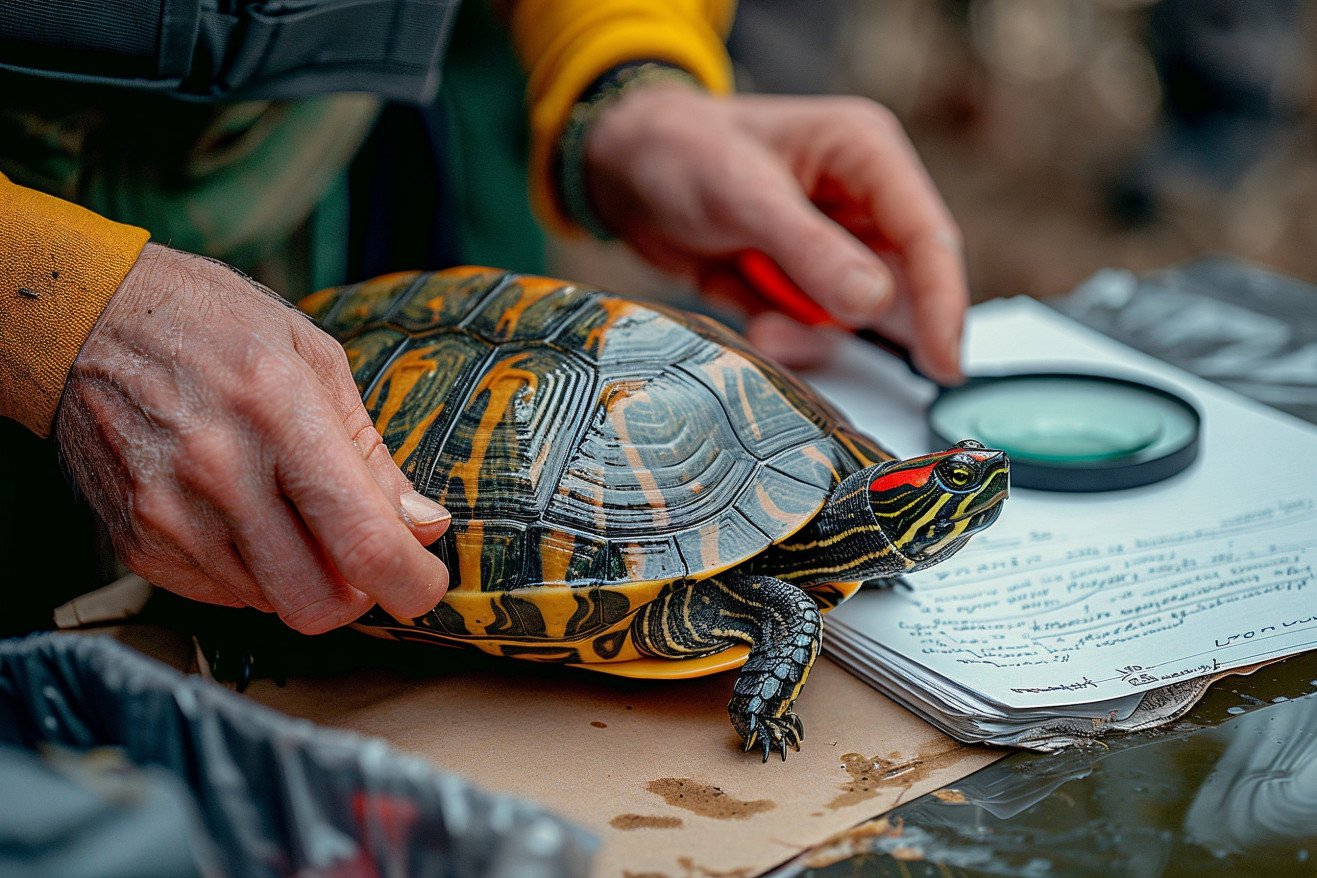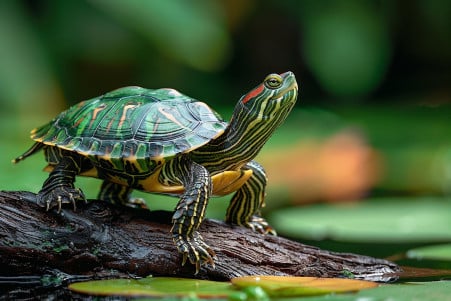How to Tell a Turtle’s Gender: Important Characteristics That Help Determine If a Turtle Is a Boy or a Girl
2 February 2024

What are some of the more subtle ways to tell if a turtle is male or female, since it’s not always so cut and dry? To tell if a turtle is male or female, look at adult turtles for differences in physical characteristics: males tend to have longer, thicker tails and concave plastrons that help with mating.
Females tend to have shorter tails and flatter plastrons. Keep in mind that it’s harder to determine the sex of juvenile turtles because these characteristics aren’t as obvious.
We will expand our knowledge of turtle sex determination by looking at a wide range of interdisciplinary research. This includes veterinary studies that focus on anatomical characteristics, as well as environmental science research that looks at outside factors that can impact turtle development.
We will also look at research in the fields of endocrinology, genetics, and ethology to better understand the physiological, hormonal, and behavioral factors that play a role in the determination of male and female turtles.
What are the most reliable characteristics for determining the sex of an adult turtle?
Breaking Down the Shell: Physical Characteristics Used to Identify Turtle Sex
There are a number of physical traits that can be used to identify the sex of a turtle, and many of them become more pronounced as the turtle ages.
According to the Olive Ridley Project, one of the most obvious differences is the length of the tail. Males have a long, thick tail that extends past their hind flippers and contains their reproductive organ. Females, on the other hand, have a much shorter tail that doesn’t extend more than 10 cm past the edge of the carapace.
The plastron, or the bottom of the turtle’s shell, also shows differences between the sexes. Males have a plastron that is concave to help with mating, while females have a plastron that is flatter. Males also have longer front flippers with claws that are elongated and curved to help them hold onto a female during mating.
These anatomical differences are used by scientists to determine the sex of adult turtles, but they can’t be used to determine the sex of juveniles. These differences are also important to know before looking at the environmental factors, like temperature, that can also impact sex determination.
Temperature and Turtle Sex Determination
Temperature is a key factor in determining the sex of turtle hatchlings. The temperature of the sand surrounding turtle eggs determines whether the turtles inside will be born male or female, a process called temperature-dependent sex determination (TSD).
According to studies published in Science and Developmental Cell and highlighted by Ars Technica, cooler incubation temperatures, which are generally below 27.7C (81.86F), lead to male turtle hatchlings in many species, while incubation temperatures above 31°C (88.8°F) lead to females.
The processes that make this happen are complex and fascinating. Some genes, including doublesex, are important because they are temperature-sensitive and are involved in the development of the gonads. The sex of the turtle is determined by the calcium concentration in the gonads, which changes with temperature and influences the expression of these temperature-sensitive genes.
Unfortunately, this delicate balance is being thrown off by climate change. According to the Embryo Project Encyclopedia, the rising temperatures associated with climate change are likely to push the temperatures at which these genes are activated past their tipping points, leading to imbalanced sex ratios that could make it difficult to conserve turtles.
As a result, it’s important to understand the details of TSD not just for scientific knowledge but also to help maintain the natural order of turtle populations.
Unpacking the Genetics of Turtle Sex Determination
The genetics of turtle sex determination is a complex topic that involves the study of sex chromosomes. Some turtles use genotypic sex determination (GSD), which means that sex chromosomes determine an individual’s sex.
A 2023 paper by Hansen et al. in PLOS ONE shows that turtles can have either male heterogametic (XX/XY) or female heterogametic (ZZ/ZW) systems, which determine the sex of the offspring. These systems demonstrate the evolutionary diversity of sex determination in turtles.
Studies have also shown that certain genes are involved in sex determination. For example, a 2021 paper by Thompson in Genetics Research demonstrates that even in species with temperature-dependent sex determination (TSD), the sex of the offspring is determined by a genetic component that is influenced by specific incubation temperatures. This combination of genetics and the environment is important to understanding the complexities of turtle development.
The genetics of turtles are also shown to be affected by a 2022 paper by Kimura et al. in Philosophical Transactions of the Royal Society B, which examines sex chromosome dosage compensation (SCDC) in species like the spiny softshell turtle, Apalone spinifera. This study shows that the production of proteins from sex chromosomes in organisms, including turtles, is subject to dosage compensation, which is influenced by genetics and environmental factors like temperature.
In summary, genetic studies have shown that the biological sex of turtles is determined by a combination of genetic and environmental factors. This information is important to understanding the broader ecological implications, including the impact of climate change, on turtle sex determination.
The Environmental Matrix: Shaping Turtle Development and Identity
The food, home, and weather that turtles experience as they grow up have a big impact on their biology and sex determination.
A 2023 article by Hansen et al. in PLOS ONE found that the gut microbiome of rehabilitating juvenile green turtles changes significantly when they switch from a diet of mixed seafood to an herbivorous diet. This change is important because the study found that the presence of certain bacteria, like Bacteroidetes, is linked to the consumption of protein, which is important for turtles during their oceanic phase before they switch to an herbivorous diet when they reach the coast.
A study in Marine Biology found that sea surface temperature (SST) may impact the diet of green turtles and their level of omnivory. The study found that higher SSTs may lead to higher levels of omnivory in turtles, which could impact their development and the process of sex determination.
Moreover, a study in Scientific Reports found that global warming may change nesting sites and the availability of food resources, which could have a wide-ranging impact on turtle populations and sex ratios. As the Mediterranean Sea heats up and nesting sites become more favorable, the change in climate impacts where turtles choose to nest and may also impact the sex ratio of populations.
Understanding these environmental influences is important for the conservation and management of turtle species. If conservationists understand how environmental changes impact turtles, they can adjust their efforts to help ensure the survival and stability of turtle populations. This ecological perspective is complemented by the study of turtle behavior, which can provide insight into their sex and well-being.
Turtle Behavior: Insights into Sex
While physical traits are often used to determine the sex of turtles, behavior can also play a role in sex determination. At Carleton University, mating behaviors in northern map turtles were studied using 3D-printed decoys.
At Carleton University, mating behaviors in northern map turtles were studied using 3D-printed decoys, and the results showed that the turtles had complex social interactions: Males were more interested in groups that included competitors, and females exhibited behaviors that suggested a social hierarchy. These behaviors could be used to determine sex, especially when physical differences are hard to detect.
In addition, A study published in Science Advances by an international team highlights how aggression may be linked to sex-based differences in the lifespans of turtles, although this is an indirect connection.
For example, Female kukri snakes show increased territorial aggression when competing for resources, including food, and this can impact their lifespan. While this study is mostly about snakes, it could have implications for turtle behavior. As a result, observing aggressive behavior in turtles may help determine sex and provide more information about the turtle in question in addition to the anatomical details.
By taking both physical and behavioral traits into account, researchers and hobbyists can better determine the sex of turtles, which can help with conservation and our knowledge of these amazing animals.
Solving the Riddles of Turtle Sex
In the quest to understand sex determination in turtles, scientists have identified several key sex-specific traits: tail length and width, plastron concavity, and species-specific traits like claw shape.
Studies have also focused on temperature-dependent sex determination, which has shown how the temperature of a nest can influence whether a turtle develops as male or female. Genetic research has shown that there are a variety of sex chromosome systems and specific genes that play a role in sex determination.
The context in which turtles live has been shown to have a variety of impacts, from the effect of dietary changes on their microbiome to the larger impact of climate change on their environment and sex ratios.
In addition to these physical and genetic factors, studies have shown that turtles’ sex can be determined by the way they interact with the world around them, with behaviors like mating displays, social interactions, and aggression indicating their sex.
Sexing turtles is not just a scientific pursuit but also a conservation necessity, and one that requires a great deal of care. Accurate sex determination is essential for research, conservation, and the well-being of these ancient creatures.
As scientists and researchers continue to study and learn from these incredible reptiles, they will refine their methods and gain a deeper appreciation for the turtles’ rich lives. This investigation demonstrates the ongoing mystery and awe that is part of the very essence of turtle life.


